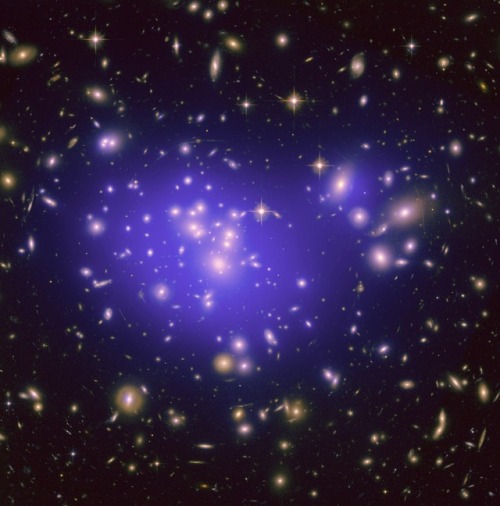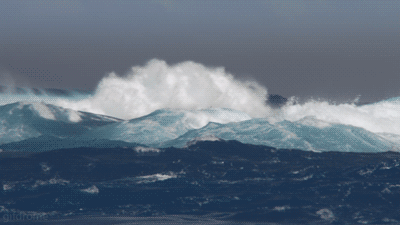Orion

Orion
More Posts from Hannahhaifisch and Others

“The earth as seen from the moon.” The young astronomer; or, Helps to a knowledge of the leading constellations. 1891.

Exchanges of identity in deep space
By reproducing the complexity of the cosmos through unprecedented simulations, a new study highlights the importance of the possible behaviour of very high energy photons
Like in a nail-biting thriller full of escapes and subterfuge, photons from far-off light sources, such as blazars, could go up against a continuous exchange of identity in their journey through the Universe. This is an operation that would allow these very tiny particles of light to escape an enemy which, if encountered, would annihilate them. This is the phenomenon studied by a group of researchers from the University of Salento, Bari, the National Institute for Nuclear Physics (INFN), the National Institute for Astrophysics (INAF) and SISSA thanks to brand new simulation models that reproduce the complexity of the cosmos as never before. Normally, very high energy photons (gamma rays) should “collide” with the background light emitted by galaxies transformed into pairs of matter and antimatter particles, as envisaged by the Theory of Relativity. For this reason, the sources of very high energy gamma rays should appear significantly less bright than what is observed in many cases.
A possible explanation for this surprising anomaly is that light photons are transformed into hypothetical weakly-interacting particles, “axions” which, in turn, would change into photons, all due to the interaction with magnetic fields. With these metamorphoses, a part of the photons would escape interaction with the intergalactic background light that would make them disappear. The importance of this process is emphasised by the study published on Physical Review Letters, which re-created an extremely refined model of the Cosmic Web, a network of filaments composed of gas and dark matter present throughout the Universe and of its magnetic fields. The aforementioned effects are now awaiting comparison with those obtained experimentally through Cherenkov Telescope Array new generation telescopes.
In this research, through complex and unprecedented computer simulations made at the CSCS Supercomputing Centre in Lugano, scholars have reproduced the so-called Cosmic Web and the magnetic fields associated with this to investigate the possibility, advanced from previous theories, that photons from a light source are transformed into axions, hypothetical elementary particles, on interacting with an extragalactic magnetic field. Axions could then be retransformed into photons by interacting with other magnetic fields. Researchers Daniele Montanino, Franco Vazza, Alessandro Mirizzi and Matteo Viel explain: “Photons from luminous bodies disappear when they encounter extragalactic background light (EBL). But if on their journey they head into these transformations as envisaged by these theories, it would explain why, in addition to giving very important information on processes that occur in the universe, distant celestial bodies are brighter than expected from an observation on Earth. These changes would, in fact, enable a greater number of photons to reach the Earth”.
In the simulations made by scientists, thanks to the wealth of magnetic fields present in the Cosmic Web’s filaments recreated with the simulations, the conversion phenomenon would seem much more relevant than predicted by previous models: “Our simulations reproduce a very realistic picture of the cosmos’ structure. From what we have observed, the distribution of the Cosmic Web envisaged by us would markedly increase the probability of these transformations”. The next step in the research? To compare simulation results with the experimental data obtained through the use of the Cherenkov Telescope Array Observatories detectors, the new-generation astronomical observatories, one of which is positioned in the Canary Islands and the other in Chile, that will study the Universe through very high energy gamma rays.
IMAGE….Through complex computer simulations, researchers have reproduced the so-colled Comsc Web and its magnetic fields Credit Vazza F., Bruggen M. Gheller, C., Wang P.

Galaxy Cluster Abell 1689
This image shows the galaxy cluster Abell 1689, with the mass distribution of the dark matter in the gravitational lens overlaid (in purple). The mass in this lens is made up partly of normal (baryonic) matter and partly of dark matter. Distorted galaxies are clearly visible around the edges of the gravitational lens. The appearance of these distorted galaxies depends on the distribution of matter in the lens and on the relative geometry of the lens and the distant galaxies, as well as on the effect of dark energy on the geometry of the Universe.
Credit: NASA/ESA

In slow motion, vortex rings can be truly stunning. This video shows two bubble rings underwater as they interact with one another. Upon approach, the two low-pressure vortex cores link up in what’s known as vortex reconnection. Note how the vortex rings split and reconnect in two places – not one. According to Helmholtz’s second theorem a vortex cannot end in a fluid–it must form a closed path (or end at a boundary); that’s why both sides come apart and together this way. After reconnection, waves ripple back and forth along the distorted vortex ring; these are known as Kelvin waves. Some of those perturbations bring two sides of the enlarged vortex ring too close to one another, causing a second vortex reconnection, which pinches off a smaller vortex ring. (Image source: A. Lawrence; submitted by Kam-Yung Soh)
Note: As with many viral images, locating a true source for this video is difficult. So far the closest to an original source I’ve found is the Instagram post linked above. If you know the original source, please let me know so that I can update the credit accordingly. Thanks!

0007





Good wood - the slightly weird but rather wonderful ‘Art and Culture Production Centre’ in the remote fishing village of Kleivan in Norway, by the Scarcity & Creativity Studio, part of the Oslo School of Architecture and Design

#SCOPENewYork 2016 | Exhibitor Highlight | Nil Gallery - Booth B05
[Ardan Ozmenoglu, Olive Tree, 2008, paint on glass, 31 x 31 in.]
@ardanozmenoglu
Find out more at SCOPE-ART.COM

38.8256322, 33.1437783







Cindermedusae - making generative creatures

-
 mariluphoto reblogged this · 2 years ago
mariluphoto reblogged this · 2 years ago -
 mariluphoto liked this · 2 years ago
mariluphoto liked this · 2 years ago -
 jalisco-y-tequila reblogged this · 2 years ago
jalisco-y-tequila reblogged this · 2 years ago -
 callthecleaner reblogged this · 2 years ago
callthecleaner reblogged this · 2 years ago -
 colorandtheshape liked this · 3 years ago
colorandtheshape liked this · 3 years ago -
 buuumpyknucklez liked this · 4 years ago
buuumpyknucklez liked this · 4 years ago -
 knowledgeukmc liked this · 4 years ago
knowledgeukmc liked this · 4 years ago -
 just-me1272 liked this · 4 years ago
just-me1272 liked this · 4 years ago -
 1ogb reblogged this · 4 years ago
1ogb reblogged this · 4 years ago -
 1ogb liked this · 4 years ago
1ogb liked this · 4 years ago -
 pinkladylover liked this · 4 years ago
pinkladylover liked this · 4 years ago -
 i-canbeloved reblogged this · 4 years ago
i-canbeloved reblogged this · 4 years ago -
 dirtyhandzz reblogged this · 4 years ago
dirtyhandzz reblogged this · 4 years ago -
 dirtyhandzz liked this · 4 years ago
dirtyhandzz liked this · 4 years ago -
 colorandtheshape reblogged this · 4 years ago
colorandtheshape reblogged this · 4 years ago -
 taydo08 liked this · 4 years ago
taydo08 liked this · 4 years ago -
 schizotypaldisorder liked this · 4 years ago
schizotypaldisorder liked this · 4 years ago -
 colorandtheshape reblogged this · 4 years ago
colorandtheshape reblogged this · 4 years ago -
 kikabarea reblogged this · 5 years ago
kikabarea reblogged this · 5 years ago -
 kikabarea liked this · 5 years ago
kikabarea liked this · 5 years ago -
 theforgottenages liked this · 5 years ago
theforgottenages liked this · 5 years ago -
 kingsavage611-blog liked this · 6 years ago
kingsavage611-blog liked this · 6 years ago -
 grubgrob reblogged this · 6 years ago
grubgrob reblogged this · 6 years ago -
 dgkdnqsd-blog reblogged this · 6 years ago
dgkdnqsd-blog reblogged this · 6 years ago -
 dgkdnqsd-blog liked this · 6 years ago
dgkdnqsd-blog liked this · 6 years ago -
 kweenkoko reblogged this · 6 years ago
kweenkoko reblogged this · 6 years ago -
 darkthirdeyeninja reblogged this · 6 years ago
darkthirdeyeninja reblogged this · 6 years ago -
 eternalangelrose reblogged this · 7 years ago
eternalangelrose reblogged this · 7 years ago -
 importanthoundweaselpurse-blog liked this · 7 years ago
importanthoundweaselpurse-blog liked this · 7 years ago -
 purplestargazing reblogged this · 7 years ago
purplestargazing reblogged this · 7 years ago -
 purplestargazing liked this · 7 years ago
purplestargazing liked this · 7 years ago -
 hatofmischief reblogged this · 7 years ago
hatofmischief reblogged this · 7 years ago -
 im-what-the-kids-call-a-mess liked this · 7 years ago
im-what-the-kids-call-a-mess liked this · 7 years ago -
 rosewateranddriedpetals liked this · 7 years ago
rosewateranddriedpetals liked this · 7 years ago -
 astralaeon reblogged this · 7 years ago
astralaeon reblogged this · 7 years ago